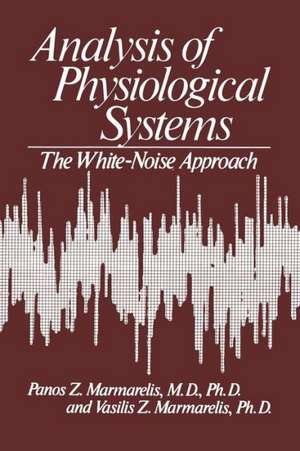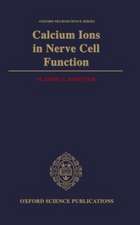Analysis of Physiological Systems: The White-Noise Approach: Computers in Biology and Medicine
Autor Vasilis Marmarelisen Limba Engleză Paperback – 29 dec 2011
Preț: 650.69 lei
Preț vechi: 765.51 lei
-15% Nou
Puncte Express: 976
Preț estimativ în valută:
124.52€ • 135.22$ • 104.60£
124.52€ • 135.22$ • 104.60£
Carte tipărită la comandă
Livrare economică 23 aprilie-07 mai
Preluare comenzi: 021 569.72.76
Specificații
ISBN-13: 9781461339724
ISBN-10: 1461339723
Pagini: 508
Ilustrații: XVI, 488 p. 75 illus.
Dimensiuni: 155 x 235 x 27 mm
Greutate: 0.7 kg
Ediția:1978
Editura: Springer Us
Colecția Springer
Seria Computers in Biology and Medicine
Locul publicării:New York, NY, United States
ISBN-10: 1461339723
Pagini: 508
Ilustrații: XVI, 488 p. 75 illus.
Dimensiuni: 155 x 235 x 27 mm
Greutate: 0.7 kg
Ediția:1978
Editura: Springer Us
Colecția Springer
Seria Computers in Biology and Medicine
Locul publicării:New York, NY, United States
Public țintă
ResearchCuprins
1. The Problem of System Identification in Physiology.- 1.1. The Problem of Systems Analysis in Physiology.- 1.2. Functional and Structural Identification of Physiological Systems.- 1.3. “Black Box” vs. Parameter Identification in Physiological Systems.- 2. Analysis of Physiological Signals.- 2.1. Physiological Systems Data: Deterministic and Stochastic Descriptions.- 2.2. Some Statistical Tools and Concepts.- 2.3. Autocorrelation and Crosscorrelation Functions.- 2.4. Frequency Domain Description of Signals.- 2.5. Certain Properties of Gaussian Signals.- 2.6. Sampling Considerations.- 2.7. Statistical Estimation from Physiological Signals.- 2.8. Filtering of Physiological Signals.- 2.9. Considerations in Computing Power Spectra.- 3. Traditional Approaches to Physiological System Identification.- 3.1. Stimulus-Response Relations in Linear Systems.- 3.2. Transfer Functions and Bode Plots.- 3.3. Transfer Functions from Stimulus-Response Spectra.- 3.4. Coherence Function.- 3.5. Mufti-Input Linear Systems.- 3.6. Nonlinear Systems: Identification Using “Describing Functions”..- 3.7. Effects of Feedback in Physiological Systems.- 3.8. Feedback Analysis in a Neurosensory System.- 4. The White-Noise Method in System Identification.- 4.1. Linear and Nonlinear Systems-The Volterra Series.- 4.2. The Wiener Theory.- 4.3. Schemes for the Estimation of the System Kernels.- 4.4. Multi-Input, Multi-Output Systems.- 4.5. Other Formulations of the White-Noise Approach.- 5. Applicability of the White-Noise Method and the Use of Quasiwhite Test Signals.- 5.1. The Band-Limited Gaussian White Noise.- 5.2. The Pseudorandom Signals Based on m Sequences.- 5.3. The Constant-Switching-Pace Symmetric Random Signals.- 5.4. Comparative Study of the Use of GWN, PRS, and CSRS in SystemIdentification.- 5.5. Validation of Generated Quasiwhite Test Signals.- 6. Methods of Computation of System Kernels.- 6.1. Computational Considerations for Kernel Measurement.- 6.2. Time-Domain Approaches to Kernel Computation.- 6.3. Frequency-Domain Approach: Use of the Fast Fourier Transform Algorithm.- 6.4. Special Cases of Kernel Computation.- 6.5. Analog (Hybrid) Methods for the Computation of Kernels.- 6.6. Evaluation of the System Kernels.- 6.7. Evaluation of Results of Experiment.- 7. Errors in the Estimation of System Kernels.- 7.1. Estimation Errors Using GWN Stimulus.- 7.2. Estimation Errors Using PRS Stimuli.- 7.3. Estimation Errors Using CSRS Stimuli.- 7.4. Errors Due to the Presence of Contaminating Noise.- 8. Tests and Analyses Preliminary to Identification Experiment.- 8.1. Determination of the System Input and Output and Region of Operation.- 8.2. Examination of System Stationarity and Noise Conditions.- 8.3. Removal of Drifts in the Response Data.- 8.4. The Measurement of System Memory and Bandwidth.- 8.5. Measurement of Extent of System Nonlinearity.- 8.6. Recording and Digitalization of Stimulus-Response Data.- 8.7. Choice of GWN Bandwidth and Record Length.- 8.8. Optimal Choice of CSRS Step and Record Length.- 9. Peeking into the Black Box.- 9.1. Analysis of Cascades in Physiological Systems.- 9.2. Zero-Memory Systems.- 9.3. Combinations of Systems.- 10. Applications of the White-Noise Method to Neural Systems.- 10.1. Practical Considerations in Application of the White-Noise Method to Neural Systems.- 10.2. Identification of One-Input Neural Systems Using GWN Stimulus.- 10.3. Identification of Two-Input Neural Systems Using GWN Stimulus.- 10.4. Identification of One-Input Neural System Using Pseudorandom Binary Stimulus.- 10.5. Identification of One-Input Neural System Using CSRS Stimulus.- 10.6. Applications of Alternate Identification Techniques to Neural Systems with Discrete Input or Output.- 11. Physiological Systems Requiring Special Treatment.- 11.1. Physiological Systems with Point Process Inputs and Outputs.- 11.2. Systems with Spatiotemporal Inputs.- 11.3. Nonstationary Systems.- 11.4. Systems with Nonwhite Random Inputs.- 12. Dialogue for Epilogue.- References.- Related Literature.
















